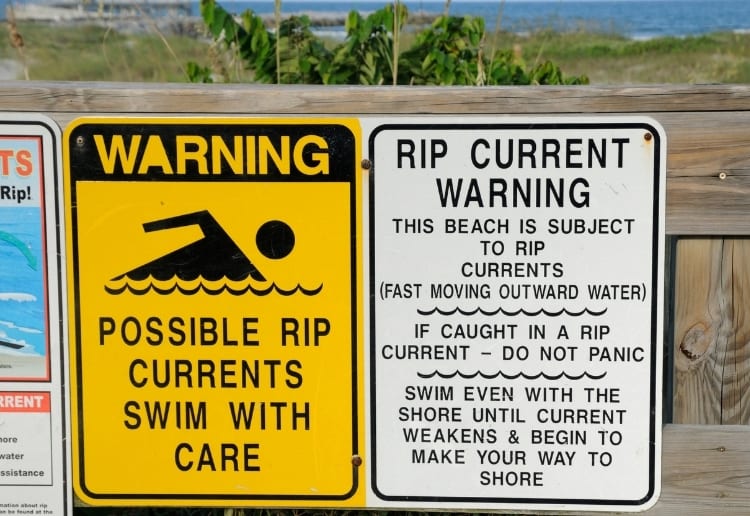Do you know how to spot a rip at the beach?
My whole life I’ve lived within half an hour of the beach. Our family holidays were always at the beach and my Dad, on top of the lifesavers (because we always had to swim between the flags) knew exactly how to spot a rip.
I’ll always remember Dad making us look out to sea from the car before we’d grab our boards and bags and race across the sand. He was forever showing us how to spot a rip at the beach. He’d point out the calm breaks between the waves and try to get our young eyes to follow the rip, look for the water flowing out to sea rather than into shore.
I’d like to think that we listened closely, paid attention and now know exactly how to spot a rip before we plunge into the waves but sometimes, when I’m at the beach with my kids and try to check, I’m not actually 100% sure.
Which is why, when I saw this post from Kenny Jewell who’s a former lifesaver pop up in my feed, I felt compelled to share it with everyone.
His explanation and the photos he’s included make how to spot a rip super clear. Clear enough for everyone to understand. So I urge you … please share this post with everyone you know and get your kids to take the time to use this to learn how to spot a rip. It’s going to be much better to take 5 minutes now than it is to have to be dragged from the surf after battling a rip.
Importantly RIPS can be DEADLY. Rips create panic. And panic makes us use up enormous amounts of energy that we should be conserving.
Knowing how to spot a rip isn’t just for the ocean. Rips can happen in any large body of water that has waves—not just the ocean, but lakes as well. They are sneaky and dangerous, but they can be avoided if you know what to look for before heading toward the water.
Here’s the facebook post from former surf lifesaver Kenny Jewell. It’s quite a few years old but it’s the most informative article I’ve ever seen. It contains timeless advice and clear visuals to help families avoid tragedy at the beach …
To summarise everything you need for how to spot a rip:
1. The easiest thing to remember is that often the safest/calmest most enticing looking area along a beach is usually a rip. A rip is usually the area devoid of wave activity and appears darker and deceptively calmer. It can sometimes appear milky or turbulent, but it is always pretty much void of wave activity. All that water coming in via waves has to go back out somehow, this is what a rip is.
2. Always take 5-10 mins when you get to the beach to observe surf conditions and identify where these areas are.
If you are caught in a rip, DO NOT PANIC. Go into floating mode and raise one arm as a distress signal when possible. See which direction the rip is taking you, is it straight out or at an angle? Once you have determined this, and if you have the energy, swim to the right or left of the direction of flow, never against.
Some rips can move at 3 times the speed of an olympic swimmer, you won’t win! If you cannot swim out to either side of the rip, just go with it. Most rips won’t take you out very far, and will usually spit you out not long after they take you, so keep calm and save your energy for the swim back to shore.
If you have kids, show them these pictures, educate them and make them aware. You can’t always be watching them, and it is only a matter of a few metres each way of the point of entry to the water that could mean them being safe, or instantly caught in a rip.
Obviously the safest place to swim is always between the flags on a patrolled beach, but this isn’t always practical given the immensity of our coast line and number of beautiful beaches. Of course there are many other factors that can come into play when it comes to beach safety, but rips are the No.1 killer. So read this article over and over … and over until you know exactly how to spot a rip.
This video from Surf Life Saving Australia is also a fantastic resource to learn how to spot a rip.
They tell us that rips occur on most Australian beaches – where there are waves and moving water, there is the potential for a rip. They also say that 70% of people can’t spot a rip when asked to and 2 out of 3 people who think they do know how to spot a rip, GET IT WRONG!






















11:00 am
10:44 pm
3:12 pm
3:48 pm
11:19 pm
1:53 pm
2:15 pm
11:32 am
7:23 pm
2:46 pm
8:08 pm
6:02 pm
3:55 am
9:46 pm
7:39 pm
12:13 pm
7:48 am
3:03 pm
3:42 pm
10:53 am
- 1
- 2
- »
Post a commentTo post a review/comment please join us or login so we can allocate your points.